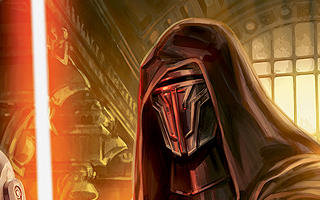Commit to Memory
Top 10 Best Video Game Save Points of All Time!
During gaming’s formative years, it wasn’t really necessary for players to have a way to save their progress. As technology improved and games became longer, saving became an essential mechanic. If a game is going to take several weeks to play through, it stands to reason that you’re going to want to take an occasional break. There are different ways to approach the saving conundrum. Early games used long-ass passwords, for example, but these have thankfully been phased out over time. Some games let players save anywhere they want at any point, while other games will automatically save at certain points. The games on this list use designated save points where players have the option of manually saving their game if they so desire. For the purpose of this countdown, we’ll be looking for creativity and inventiveness. The most interesting save points are the ones that somehow tie into a game’s narrative or overall theme. Much in the same way that those who cannot remember the past are condemned to repeat it, those who cannot save their game are condemned to replay it.
10
Coffins
Castlevania: Symphony of the Night

There are a handful of conventions that apply to seemingly every vampire. They have sharp fangs, they can transform into bats, and they vant to drink your blood. They also have a tendency to sleep in coffins, of course, which explains why Alucard is relaxing in one when he’s first introduced in Castlevania III. Coffins help emphasize the fact that vampires are members of the living dead, and they’re practical for other reasons as well. Exposure to the sun can literally kill a vampire, so it’s important for them to sleep inside something that will keep the sunlight out. In Symphony of the Night, Alucard saves his progress by resting in pulsating coffins located at various locations within Dracula’s castle. These coffins don’t seem out of place at all, and we can assume that Dracula himself uses them from time to time. One of the most useful things about the coffins is that they can completely restore your health. The effect is almost instantaneous, and Alucard doesn’t even need to fall asleep in order to reap the benefits. It probably wouldn’t be hard to fall asleep, however, since the save rooms are devoid of music. This ultimately makes everything feel calm and relaxing. Dracula’s architect is the real hero in this scenario, since he was thoughtful enough to place the coffins in close proximity to teleport rooms and boss arenas!
9
Water Fountains
Prince of Persia Series

In Prince of Persia: The Sands of Time, the Prince could save his progress by entering sand vortexes that would typically appear after a battle. If he wanted to replenish his health, however, he had to track down a bath or a fountain somewhere within the palace. The fountains in Warrior Within offered the best of both worlds. Although they retained their restorative powers, they also functioned as save points. The hidden fountains in The Two Thrones were even more useful. These fountains were sometimes located behind broken walls or at the end of mysterious hallways, and you were typically required to venture off the beaten path in order to find them. It was well worth the effort, though, since they would permanently increase the Prince’s health bar. Even though the Prince can potentially turn back time to correct his mistakes, it’s never a bad idea to take a drink from one of these fountains. Fountains are thematically appropriate for the series, and I’m sure anyone who lives in the desert can likely appreciate how invigorating a simple drink of water can be.
8
Save Capsules
Super Metroid

The NES version of Metroid was one of the first games that let players save their progress with a password, but the original FDS version let you save directly onto the disk. In either regard, a save system was necessary since the adventure was too long for most people to play through in a single sitting. Saving has been an important part of the series since the very beginning, but Super Metroid had the most fun with the concept. In this outing, players can visit capsule-like save stations that are located in designated rooms. In many cases, these stations are conveniently located near bosses in order to provide players with a safety net. This convention is turned on its side when you visit the wrecked ship, however. In this area, you have to fight the boss before you can use the save station! The ship’s power is turned off when you first arrive, which means that none of the electronic equipment is working. This naturally includes the save station, so you’ll have to defeat the boss before power can be restored. This twist made you realize that you had been taking the save capsules for granted, and it also made them feel like a more integral part of the game’s world.
7
Access Points
NieR:Automata

In NieR:Automata, you can only save your progress when you’re near an Access Point. This sounds like a pretty simple concept on paper, but it’s more complex than you might imagine. Firstly, you’ll have to unlock each Access Point before you can use it. This is easier said than done, however, since enemy robots have a tendency to attack them with reckless abandon. Fortunately, Access Points are pretty easy to find after you complete the prologue. They also act as teleport locations, so there’s an added incentive to track them down. (Obviously, being able to fast travel to various locations will significantly cut down on your playtime.) The most interesting aspect about the Access Points is how they’re woven into the game’s narrative. Within the contexts of the story, the Access Points allow the android protagonists to upload their memories to mission command in outer space. In the event that they die, they’ll simply be replaced by an identical android who has been imprinted with these aforementioned memories. The game raises all sorts of questions about existentialism, but I certainly wasn’t expecting this theme to be integrated into the save system.
6
The Safe Haven
The Evil Within

In The Evil Within, players can save their progress by visiting the Safe Haven. Since there are no enemies in this asylum, it’s the perfect place to upgrade your abilities or rummage through newspaper clippings. The Safe Haven is divided into a number of sub-areas – including jail cells and a morgue – but you won’t have to venture past the reception desk if you just want to save your game. When you first arrive in the Safe Haven, you’ll meet a nurse named Tatiana who explains in great detail why it’s important to cherish your memories. Players can access the Safe Haven by finding mirrors in certain areas throughout the game. Whenever you’re in the vicinity of one of these mirrors, Debussy’s Clair de Lune plays as an audible cue. In certain occasions, other reflective surfaces (like windows) can be used as a portal to the Safe Haven. Interestingly, the area undergoes many changes as the player progresses through the game. Things start to look grittier and more run down, and it starts to feel like the entire place has been abandoned. There’s an element of mystery surrounding the Safe Haven that never really goes away. It’s also worth mentioning that The Evil Within has a DLC chapter that lets you save your game by petting a cat! This is almost as remarkable as the asylum concept.
5
Telephone Terminals
Alien: Isolation

More often than not, a save point in a video game also acts as a safe point where you don’t have to worry about any imminent threats. In Alien: Isolation, the save points are just as nerve-wracking as the rest of the game. There is no auto-save functionality, so you’ll have to manually save your progress by using emergency phone terminals. This sounds simple enough, but there are several steps involved. After finding a phone, you’ll have to insert your access card and wait for the terminal to boot up. If everything goes right, you’ll eventually see three lights indicating that the save was successful. The world doesn’t come to a halt just because you’re using the phone, however, which means that you’re in constant danger throughout the entire process. You’ll be kicked all the way back to your previous save if you die, and this creates an interesting risk-reward scenario every time you come across a new save station. You might be compelled to make a beeline for the terminal as soon as you see it, but this could be an invitation to be flanked by the enemy. On the other hand, if you choose to scout out the area before saving your progress, you could wind up walking right into an ambush. The phone terminals take your on a roller coaster ride of emotions. You’ll be excited when you find them, anxious while you’re using them, and relieved when they eventually do what they were designed to do.
4
Save Frogs
Mother 3

In EarthBound, Ness could save his progress simply by calling his dad on the phone. Although his father was busy working, he always had time to talk to his son. This premise was also used in the first Mother game, and Ninten also had to call home whenever he wanted to save. This system worked well since phones were located all over the place, but Mother 3 took things in a bold new direction by introducing Save Frogs. These little guys could be found almost anywhere. Whether you’re exploring caves or using the bathroom, chances are that there was a Save Frog nearby. They hid in barrels, rode in limousines, and hung out in movie theatres. Some of them are more elusive than others, of course. One of the frogs had been eaten by a snake, for instance, while another could only be encountered if you ate hallucinatory mushrooms. You could also meet a ghost frog, a scuba-diving frog, and a frog that was attached to a balloon. Each Save Frog had its own story behind it, and it’s exceedingly rare for save points to demonstrate so much variety.
3
Bonfires
Dark Souls Series

Strictly speaking, the bonfires from Dark Souls could more accurately be described as checkpoints rather than save points, but there’s no reason to be pedantic. If you light a fire, you’ll be able to respawn there after you die. In this capacity, your progress is being saved. Needless to say, it’s a big relief to stumble upon a new fire location after a grueling boss fight. One of the big benefits of bonfires is that they give players an opportunity to level-up or reinforce their stats. Unfortunately, there’s also a downside to the system. Although you’ll replenish your health by resting near a bonfire, you’ll also revive nearby enemies in the process. You’ll be safe so long as you’re by the fire, but there’ll be a world of hurt waiting for you when you continue your journey. Although bonfires can relieve your stress, they can also create problems for you down the line. It’s rare for a checkpoint system to be so nuanced. It’s easy to see why FromSoftware used a similar save system when they developed Bloodborne.
2
Typewriters
Resident Evil Series

One of the things that defined the early Resident Evil games was the concept of conservation. Players were given limited ammunition, and health items weren’t always easy to find. It was never safe to let your guard down, and this ultimately made every zombie encounter all-the-more intense. Remarkably, the concept of conservation was carried over into the save system as well. You could save your progress by using typewriters that were conveniently located throughout the games, but you typically needed to have an ink ribbon in order for a typewriter to be functional. Since these ink ribbons were limited in number, you were encouraged not to save unless you really needed to. If you didn’t use your ink ribbons sparingly, you could potentially back yourself into a corner. In most games, finding a save room is like a sigh of relief. In Resident Evil, you’re forced to evaluate how well you’ve been playing before deciding whether or not to save your progress. As an aside, I’m not sure why typewriters are so common in the series. The first game takes place in a mansion that has dozens of designated typing rooms for some reason. The premise is even more ridiculous in Resident Evil 4, since the game takes place in a remote European village. Why are there so many random shacks with typewriters in them!? Sadly, Resident Evil 5 adopted an auto-save system that eliminated the need to conserve anything. This effectively derailed the entire series.
1
Toilets
No More Heroes Series

In No More Heroes, you save the game by having Travis Touchdown use the bathroom. A toilet seems like an unlikely choice for a save point, but it’s an appropriate reflection of the game’s sophomoric tone. The save system is a literal example of toilet humor, and it speaks to Travis’ flippant nature. As an added bonus, the placement and frequency of the save points feels surprisingly organic. Bathrooms are found in nearly every building, after all, so the developers had free reign to place them wherever they wanted without anything seeming unusual or anomalous. (No More Heroes isn’t especially concerned with immersion, mind you, but it’s always nice when you’re able to anticipate where your next save point will be.) There’s another reason why the bathrooms make for suitable save points. In many households, the bathroom is the only place where you have any semblance of real privacy. Much in the same way that a guy might spend an inordinate amount of time in the bathroom to escape from his nagging wife, Travis uses the privacy of a bathroom as a temporary sanctuary to protect himself from those that are trying to put him into an early grave.





Do you agree with this list? Let us know what you think by leaving a comment below. Your opinion matters!